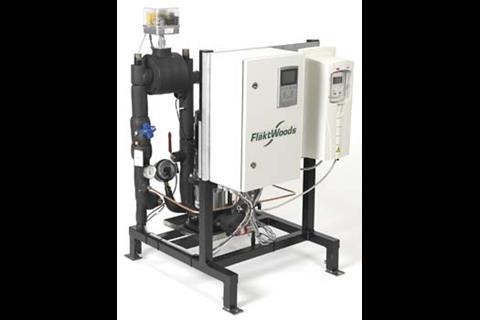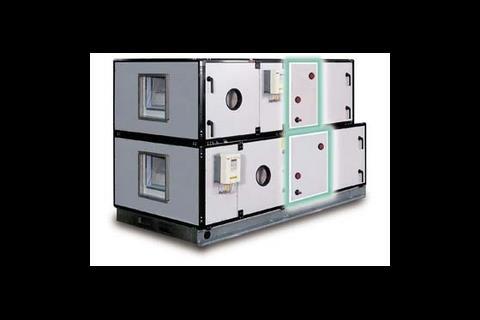Combining run-around with heat-transfer coil technology could be the answer to a common services design dilemma. BSj examines the compact Econet unit
Fresh air or energy efficiency? It is a difficult choice for most designers. A high level of fresh air will significantly improve a building’s indoor air quality, but increasing the amount of fresh air supplied will also increase the amount of energy needed to heat or cool the air, filter and distribute it. Striking the right balance is important, particularly in hospitals where fresh air can help in infection control.
One way of capturing and reusing the energy in the air exhausted from the building is to use a heat recovery device. Efficient ways of doing this include a thermal wheel, a plate heat exchanger or a run-around coil. However, plate heat exchangers are difficult to clean and thermal wheels – the most efficient method of heat recovery – cannot be used for applications where odour and bacteria transfer are critical.
Run-around coils would appear to offer the best solution for hospital applications, but until now their efficiency (generally 45% to 55%) has limited their use. A new packed high efficiency energy recovery system from manufacturer FlaktWoods might just be the solution to the designer’s dilemma.
Called Econet, it takes the basic operating principle of a run-around coil and then enhances it with high efficiency heat-transfer coils and the addition of a packaged optimised control system. The new system is claimed to be up to 50% more efficient than a standard run-around coil and to have a heat recovery efficiency of up to 75%.
Heat exchanger included
In addition to the two energy recovery coils, the Econet unit incorporates a heat exchanger. This enables the system to supply additional heating or cooling energy to the supply air, eliminating the need for more heating and cooling coils in the air-handling unit and their associated pumps, valves and pipework.
What’s more, the system’s use of high-efficiency heat transfer coils means low-grade energy can be used if the supply air does needs some additional heating or cooling. For example, waste heat from a chiller condensate can be used for heating or borehole water used for cooling.
A run-around coil uses two heat exchangers, one mounted in the exhaust air stream, the other in the fresh air supply duct. The heat exchangers are usually a coil, similar to the heating or cooling coils found in an air-handling unit. These heat exchangers are connected by pipework. Water is then circulated through this pipework to transfer heat (or coolth) from the coil in the exhaust air-stream to the coil in the supply air-stream.
The system is flexible because there is no risk of cross-contamination between the supply and extract air-streams and also because, where necessary, the connecting pipework allows the extract coil to be in a different room from the supply air coil.
Like the basic run-around system, Econet comprises a single coil in the supply ductwork and a second coil in the exhaust duct. Usually, these coils are installed within an air-handling unit. The system uses larger-than-usual heat-transfer coils, which can be up to 12 rows deep and can contain up to 76 waterways. Large coils are used to maximise the amount of energy transfer. “The large coils enable us to achieve energy recovery efficiencies in the region of 70-75% at equal supply and extract airflows,” says Craig MacFadyen, systems project manager at FlaktWoods.
The coils are connected using what MacFadyen rather unsuccinctly terms ”a packaged, pre-piped, pre-configured, pre-programmed and pre-commissioned liquid-coupled, pumped energy recovery system”. The package also includes an inverter-drive for the pump, optimising controls and all valves and sensors to enable the system to operate. “Water is more efficient than air at transferring energy so we use as much of this medium as possible to maximise energy recovery,” MacFadyen explains.
Shorter units
Using such large coils means the supply air’s total heating and cooling requirements can be met without the need for additional heating and cooling coils. This means the air-handling units can be between 1.6m and 2m shorter than if they had incorporated heating and cooling coils (based on the length of a heating coil, cooling coil and two 500mm access sections).
The exception to this is where dehumidification is specified and a re-heater is installed in the supply unit. This has obvious benefits where the unit is to be located in a small plantroom. Alternatively the unit’s reduced size could mean that a smaller plantroom is required.
To meet any additional demand, supplementary heating or cooling can be added to the Econet system through heating and/or cooling heat exchangers. The high surface area of the large coils is what creates the additional benefit of allowing low-grade energy to be used. According to MacFadyen, this means the system can be used with a CHP system or a district heating and cooling systems. He says to supply air at, say, 16ºC, the system can use water at a temperature of about 11-13ºC.
“This means the system is ideal for use with borehole water, so all the cooling energy can be supplied from a renewable source,” he says. “This should suit areas such as London, where the use of renewables is mandatory.”
Even without borehole water, the system is efficient enough to provide cooling without the need for chilled water at 6ºC. The increased coil size means that much higher chilled water temperatures can be used, increasing the coefficient of performance of the chillers, reducing the amount of energy required to provide cooling. Where the system is used with a district cooling scheme, an operator will be able to utilise the slightly warmer chilled water, which is generally on a cheaper tariff.
Low-grade heat
The unit can also make use of low-grade heat for heating. To supply air at 25ºC, hot water at 35ºC should be sufficient. This is the temperature of condensate water, so waste water from chillers can be used. And if “normal” chilled water temperatures of 6ºC flow and 12ºC return, or hot water temperatures of 82ºC flow and 72ºC return are used, then much lower water flow rates are needed, which will significantly reduce the size any pipes and valves required.
The system’s optimised controls work out the most energy efficient method of achieving the required supply air temperature, whether through heat recovery or the use of waste heat, or from any other scenario using the optimising control system.
Econet is starting to be used more and more in Scandinavia, but there are very few examples of it in the UK. MacFadyen says the most obvious application for the unit is in hospitals and process applications, such as pharmaceutical production plants – “because it is a run-around coil system and so there is no crossover of air; and because it uses only one coil in the supply air system cleaning and maintenance time is reduced”.
Another common application is supermarkets, because of the unit’s ability to make use of waste heat. “Bearing in mind supermarkets have chillers running 365 days a year, Econet can provide all the stores’ heating through the use of chiller condensate water only,” MacFadyen explains.
The units are also suitable for use in offices, where there is insufficient space for heat recovery, or in speculative offices where plant space needs to be kept to a minimum. Perhaps it will not be long before Econet becomes a more common feature of air-handling design in the UK.
Downloads
Winter – airflow 8.5m3/s
Other, Size 0 kbSummer – airflow 8.5m3/s
Other, Size 0 kb
Source
Building Sustainable Design























No comments yet